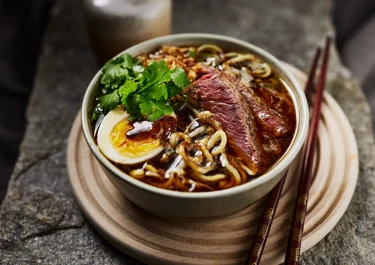
Beef ramen

Instructions
Broth
Black garlic butter
To serve
Beef ramen
If you sometimes turn to instant ramen as a quick lunch or snack, our recipe can give you a hint on how to level up the flavours, textures, and nutrition in your bowl. Some sautéed mushrooms and an egg will work wonders. Add green onions, bean sprouts, and coriander and your instant noodles will transform into a bowl of delight.
There is a wide range of toppings that you can add to your beef ramen. How about some sliced sugar snaps for sweet crunch, or pickled daikon radish? Veggies like bell peppers, raw or sautéed, bamboo shoots, and bok choy are also great for adding crispy texture and nutrition to your ramen. In the end, it’s your personal preferences and imagination that decide what your beef ramen should look and taste like.
If you’re looking to spice up your beef ramen, you can try the authentic Japanese spice blends furikake and togarashi. Furikake has seaweed, dried fish, sesame seeds, sugar and salt that add depth and savouriness to any dish. Togarashi is a much spicier blend of seven spices, such as chilli peppers, Sichuan peppercorn, and ginger that will turn up the heat in your bowl. A dash of sriracha chili sauce is another easy way to give your ramen more punch.
Ingredients
Broth
|
Mushrooms
|
200 g |
|---|---|
|
Chives
|
100 g |
|
Garlic cloves
|
4 |
|
Butter, for frying
|
|
|
Finely grated fresh ginger
|
17 g |
|
Chilli flakes
|
tsp |
|
Cane sugar
|
12¾ g |
|
Beef stock, or 3 bouillon cubes
|
4 tbsp |
|
Japanese soy sauce
|
2 tbsp |
|
Sesame oil
|
2 tbsp |
|
Salt
|
½ tsp |
Black garlic butter
|
Garlic cloves
|
6 |
|---|---|
|
Cooking oil
|
3 tbsp |
|
Butter
|
100 g |
|
Salt
|
½ tsp |
To serve
|
Sirloin steaks (150 g each)
|
2 |
|---|---|
|
Salt and black pepper to taste
|
|
|
Butter
|
29 g |
|
Ramen noodles
|
200 g |
|
Bean sprouts
|
72 g |
|
Fresh coriander
|
1 bunch |
|
Roasted onions
|
23 g |
|
Boiled eggs (optional)
|
2 |
Chinese comfort food at its best
Get your slurp on with noodles and beef in savoury broth. While not exactly ‘instant,’ this ramen recipe is quick, easy, and 100% satisfying.
Ramen with beef – a classic dish from China
Japanese noodles in flavourful broth with meat, mushrooms, or vegetables – ramen has become a global street food favourite. Ramen has its deepest roots in China and became popular in both Japan and China in the early 1900s. Once you try ramen it’s easy to understand its appeal: silky noodles and warming, savoury broth, often complemented with spices and herbs, coming together to create comfort food in its purest form.
Try these variations
Ramen noodles are often served in chicken or beef broth, with slices of pork, beef, or chicken on top. But meat is not a prerequisite for a mouth-watering bowl of ramen. Simply use vegetable or mushroom broth, seasoned with soy and your choice of herbs. Add sautéed mushrooms like shiitake or enoki on your noodles, together with sliced spring onions and steamed pak choi, and you’ll enjoy a satisfying mix of flavours and textures with your noodles. You can also serve half a soft-boiled egg on top, which you can marinate in soy sauce for a few hours before serving.
The best way to serve ramen with beef
Ramen is considered casual dining. The bowl of noodles can be served on its own or with a small side such as edamame beans, a salad, or gyoza dumplings. A chilled beverage is also a great accompaniment to the savoury broth. The authentic way to eat ramen is with chopsticks. Keeping your face close to the bowl, you use the chopsticks to grab noodles and slurp them into your mouth, without worrying about the sound. A spoon and fork are of course helpful for those who aren’t comfortable with chopsticks.
Storage tips
The ingredients in ramen soup are kept separate until each bowl is prepared. While the broth and other ingredients can be kept in the fridge for a couple of days and then reheated, the noodles really should be made fresh to serve. Keeping noodles in the broth for several hours will most probably make them swell and become soggy. You can also freeze the broth in an airtight container for up to a month. Defrost the broth overnight in the fridge and reheat to a gentle simmer on the hob.










